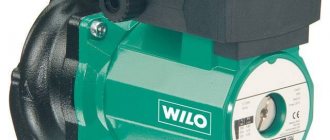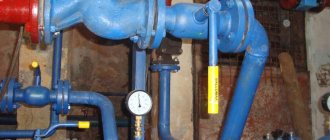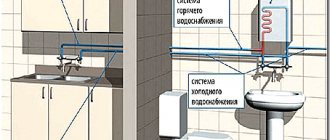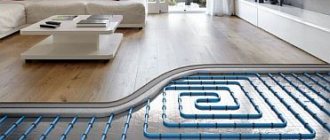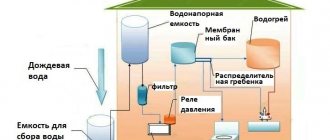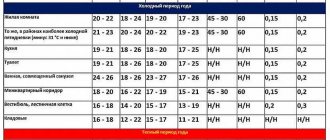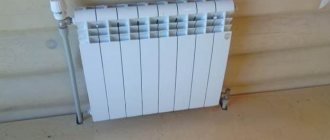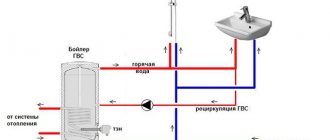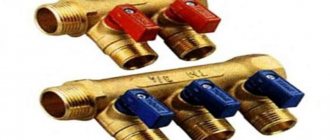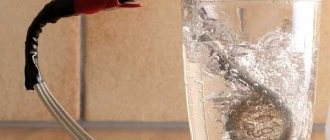Calculation of the heating network make-up deaerator.
rice. 2.6. Design diagram of a vacuum deaerator.
opodpvd
2.10.
Calculation of the HDPE system. 424 dr4525
dr5626 dr6727 dr7't Fig. 2.7. Design diagram of the HDPE system.
6t5tpsouupltdvut'prtnevozvtt7oetktoo
2.11. Determination of steam flow to the turbine and checking its power . 3. Thermal calculation of HDPE and optimization of its characteristics on a computer. Initial data for PND 4:
- heated water consumption Gw=0.84102=85.7 kg/s;
- inlet water temperature tв1=136 оС;
- heating steam pressure P=0.52 MPa;
- saturation temperature of heating steam tn=153 oC;
- temperature difference of the heater t=2 оС
- latent heat of vaporization r=2102 kJ/kg;
- average heat capacity of water av=4.19 kJ/kg oC;
- internal diameter of pipes din = 0.018 m;
- pipe thickness =0.001m;
- thermal conductivity of brass st = 85 W/m K;
- distance between partitions H=1 m;
- water speed c=2 m/s;
- price of a ton of standard fuel Ct.t.=60 $/t.t.e.;
- specific cost of the heater surface kF=220 $/m2;
- heat extraction coefficients j+1=0.4 and j=0.267;
- number of hours of use of installed capacity hsp = 6000 h;
- Boiler efficiency ka=0.92;
- Heat flow efficiency tp=0.98.
ooo Physical properties of water at tвf.
322
Physical properties of the condensate film at tn.
3222oooo2ntr
4. Determination of heat value coefficients. Calculation of power change factors. We will calculate the value coefficients of the heat of the extractions using the formula: Analysis of technical solutions using the CCT of extractions.
- Reducing the temperature pressure in HPH 6 by 1 °C.
- Installation of superheated steam cooler.
- Installing a drainage pump on HDPE 2.
- Installation of the expander.
- Increase in pressure loss in the extraction pipeline to HDPE 4 by 2 times.
ooo
- Installation
of drainage cooler on PVD 6.
5. Calculation of technical and economic indicators. 6.Selection of auxiliary equipment for turbine installation.
- We select feed pumps to supply feed water at the maximum power of the installation with a margin of 5%:
pnpv
- We select condensate pumps based on the maximum steam flow into the condenser with a margin:
knc
- We select drainage pumps without reserve (reserve - cascade drainage) type KS-32-150 (PND 6).
- We select low-pressure heaters of type PN-200-16-7 I in the amount of 4 pieces.
- Three high-pressure heaters, type PV-425-230-35-I.
- We select deaerators with a deaerator column type DP-500M2 and a deaerator tank type BD-65-1.
Conclusion.
o2
Literature.
2
Selection of circulation pump
The circulation pump helps to identify pressure losses in all sections of the pipeline. To determine the pressure required by the pump to pump coolant through the system, use the formula: P = Rl + Z, where:
- P - decrease in pressure in the line (Pa);
- R - relative resistance to adhesion (Pa/m);
- l is the length of the pipe of one section of the heat pipeline (m);
- Z—pressure reduction in narrow-gauge zones (Pa).
Such calculations are extremely inconvenient and time-consuming, whereas to determine the Rl value of all sections of the pipeline it is enough to use Shevelev’s tables. It must be remembered that pump performance is the total coolant consumption, and not the capacity of the heating system.
Average data
If for some reason the user cannot determine the exact volume of water or antifreeze in heating radiators, then average data that is applicable to heating radiators of certain types can be used. If, say, we take a panel radiator of the 22nd or 11th type, then for every 10 cm of this heating device there will be 0.5-0.25 liters of coolant.
There is another way to determine the internal volume of the radiator section - close the lower necks, and through the upper ones, pour water or antifreeze into the section to the top. But this does not always work, since aluminum alloy radiators have a rather complex internal structure. In such a design, it is not so easy to remove air from all internal cavities, so this method of measuring internal volume for aluminum radiators cannot be considered accurate.
2.6. Main and auxiliary equipment of heating plants
The water supplied to the heating network for the needs of consumers at the CHP plant is heated in network heaters of turbine units, in peak heaters and in peak water heating boilers, which belong to the main heating equipment of the CHP plant. Auxiliary heating equipment includes: heating network make-up unit, network pumps, storage tanks, recirculation pumps of hot water boilers, etc.
Peak water heating boilers (PHBs) are designed for installation at thermal power plants to cover peak heating loads.
Peak hot water boilers are usually installed in separate rooms at large CHP plants or in the main building at small CHP plants. The fuel for these boilers is mostly fuel oil or gas. Due to their low use throughout the year, peak boilers are simple in design and inexpensive. The building can be carried out only for the lower part of the boilers, while their upper part remains in the open air. Before the CHP plant is put into operation, hot water boilers can be used for temporary centralized heat supply to the area. The network water is heated sequentially in network heaters to 110÷120C, and then in the PVC to a maximum of 150C.
To avoid corrosion of the boiler metal, the temperature at its inlet must be no lower than 50÷60C, which is achieved by recirculating and mixing hot and cold water. The calculated efficiency of hot water boilers using gas and fuel oil reaches 91÷93%. Coal-based PVCs are produced and used. They have their own dust treatment, smoke exhausters and other equipment.
Steam-water heaters for heat treatment plants
are designed for heating network water with steam from turbines or boilers through reduction-cooling units (abbreviated ROU).
Network pumps
serve to supply hot water through heating networks and, depending on the installation location, are used as first lift pumps supplying water from the return pipeline to network heaters; second rise to supply water after network heaters to the heating network; recirculation installed after peak water heating boilers.
Network pumps must have increased reliability, since interruptions or malfunctions in the operation of pumps affect the operation of thermal power plants and consumers.
The main feature of the operation of network pumps is fluctuations in the temperature of the supplied water over a wide range, which in turn causes a change in pressure inside the pump. Network pumps must operate reliably over a wide flow range.
Typically, network pumps are centrifugal, horizontal, driven by an electric motor.
Heating mains: two-pipe, one-pipe
For space heating, two types of mains were designed: single-pipe and double-pipe.
Single-pipe, double-pipe lines
They differ in the way they connect heating devices to the system.
- In single-pipe systems, the connection is serial, the return of the previous radiator is the input for the next one.
- In two-pipe systems, the return flow is immediately diverted into a separate line to the heating boiler.
Single-pipe systems are effective for heating small areas of up to 100 sq.m per floor, while double-pipe systems can cope with larger areas. The difference is in the area on one floor, the amount of materials in the system.
Differences in heating lines:
Due to differences in design, different standards have been developed for the systems.
For a two-pipe system, the maximum heating of the coolant is 10 °C more than in a single-pipe system - 105 °C, at the same return temperature - 70 °C.
Principle of operation
From the physics course we know that fluid is incompressible.
In the heating circuit, water is used as a coolant.
In the temperature range from 20 to 90 degrees, it changes volume, expanding as it heats up.
If we imagine a heating network as a vessel of complex configuration, then heating the contents will cause the walls to rupture due to expansion of the liquid.
To compensate for this phenomenon, an expansion tank is used, which serves as an additional volume for storing excess coolant.
Having expanded, the water enters the tank, and when cooled (approximate prices for a heating cable for water supply) it goes back into the system.
It is simply impossible to remove excess water, since when it cools, air will fill the void and the circuit will cease to function.
Do you know what to do if water flows from the tank into the toilet. Read this useful article for tips and recommendations from master plumbers on troubleshooting.
The scope of application of asbestos-cement pipes measuring 150 mm is written on this page.
Thus, the expansion tank protects the heating system from both excess and shortage of coolant, compensating for all movements of its volume.
What you need to know when performing calculations
In some cases, the volume of the heating system can be determined experimentally. In this case, the structure is filled from the water supply system with marks on the meter for water consumption. If this method does not work, then you will need to carry out mathematical calculations. In this case, the summation of the volume indicators of all circuits and devices that are in the system is performed. Some parameters can be determined, and other indicators are calculated using geometric formulas.
For example, technical documents indicate the volume for boilers. An important indicator is the volume of the special tank
When using any tank, it is important to note that it should not be filled to the very top. This is specifically taken into account in the program
The table shows the boiler power indicators
In some cases, it is important to calculate the volume without an expansion mechanism. In this case, in the column where the expansion tank is indicated, you must put a zero
In this case, the calculated indicator will become decisive when choosing a suitable design.
The expansion tank is an important part of the heating system, which must be suitable for its characteristics.
The volume of the heat exchange device is also important. In the case of collapsible batteries, the number of sections and their type are indicated. At the same time, the volume of the most popular radiators is already taken into account in the program. For non-removable convectors, it is necessary to indicate the design value according to the passport. If the building has heated floors, then the calculation is performed depending on the type of pipes and the sum of the lengths of all circuits. The database contains special columns for plastic lines and for unreinforced PEX.
The largest volume of the heating system is occupied by the return and coolant supply circuits. During installation, different types of lines can be used, which differ in diameters and materials of manufacture. Internal diameters may also differ, which affects the volume. This is taken into account in the calculations. In this case, you need to measure individual sections of pipes and indicate this in the appropriate fields. Various types of pipes are introduced: metal-plastic, steel or polypropylene.
Non-freezing coolant option
The system can also install other mechanisms that affect volumes. These include factory-type manifolds, hydraulic separators and boilers. If there are any devices, they are also entered in the corresponding columns of the program.
The final result is displayed in liters.
Save time: selected articles delivered to your inbox every week
Coolant
Heating requires a coolant that transfers heat from the source to the final consumer. The transmission efficiency depends on the viscosity.
In addition to viscosity, the coolant must meet the requirements for the absence of a corrosive component.
An important property is the ability to lubricate the surfaces of highways. The choice of heating system materials, units, mechanisms depends on the coolant
The heat carrier must not be toxic.
Types of coolants
Water as a coolant
The first thing people pay attention to when choosing a heating fluid is water. Has universal properties, is available
Being in its natural state, it has the best heat capacity - 1 kcal. If water gives off heat with virtually no losses when cooling, it is maximum heat transfer.
Has good viscosity. Specific density is about 1000 kg/m².
Eco-friendly. In the event of a heating system emergency, you don’t have to worry about toxic safety—in case of unplanned leaks, the water will not cause harm to your health.
Water in nature contains salts and gases, the presence of which in the heating system is not desirable. Natural water needs to be prepared and purified.
You can't get by with filtering. The easiest way is boiling. Water gets rid of salts in the form of scale. In addition to salt, boiling removes carbon dioxide. It will not be possible to remove all the salts.
If the composition of the water does not allow purification by boiling, resort to chemical methods. You will need slaked lime, soda ash, sodium orthophosphate. When elements are added, soluble salts become insoluble. All that remains is to filter the treated liquid, which can be done in the heating system.
However, it is better to use distilled water. You can make it yourself or purchase it.
Antifreeze as a coolant
Antifreeze has good technical performance; there is no risk of the system freezing when it is idle in winter.
Antifreezes protect the system from corrosion and lubricate well. Additives can be added for specific purposes, such as rust removal.
However, antifreeze has a lower heat capacity and releases heat more slowly than water; the viscosity is high, a circulation pump is needed; penetrating ability is higher, more thorough sealing of heating system components is required; toxicity.
Video: “What to put in the heating system?”
